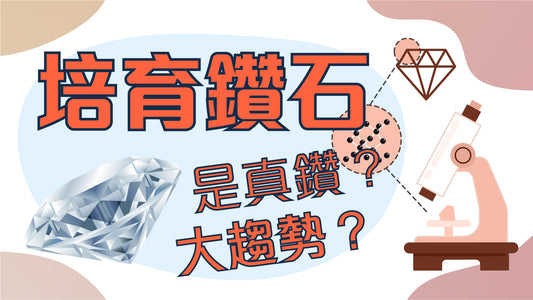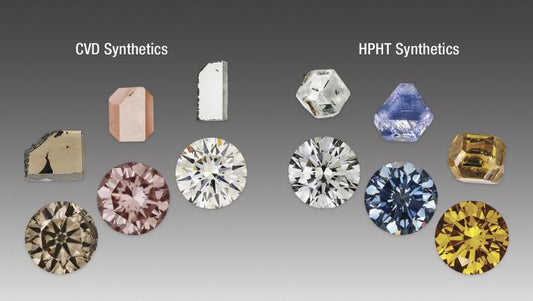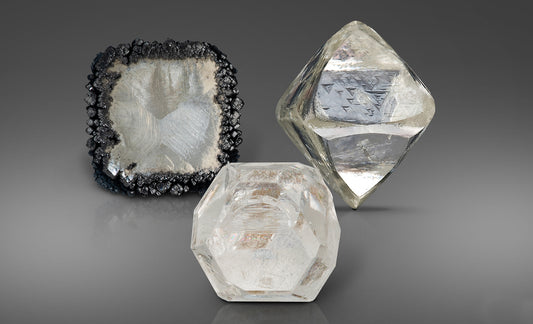There are two main technologies for making lab grown diamonds, which are Chemical Vapor Deposition (CVD) and High Pressure High Temperature (HPHT).

CVD-grown rough diamond on the left, HPHT-grown rough diamond in the middle, and natural rough diamond on the right
Chemical Vapor Deposition
Chemical Vapor Deposition is abbreviated as CVD. Scientists add carbon atoms into an ion gas reactor and grow diamonds at low pressure high temperature (about 700°C-1300°C). As the temperature gradually increases, molecules in the gas separate and grow on the substrate layer by layer.

In general, this method takes about 4 to 6 weeks, and growth time directly affects the final diamond size. CVD technology requires multiple removal of the graphite layer to form a larger diamond, so it is generally time-consuming and difficult.

A lab grown diamond crystal (left) inside a CVD vacuum chamber. After the crystal has grown, it is removed from the vacuum chamber (right) and is usually covered with a black layer of carbon.
The color of lab diamonds produced using CVD technology is mostly F-H color. Therefore, when it has finished growing, it is often necessary to go through HPHT method to change its color, including making it more colorless or giving it a fancy color.
The Advantage of CVD Method
- Lower equipment set-up costs than HPHT technology
- The carat weight is usually higher (the weight of the finished product is basically greater than 1ct, or even greater than 3ct)
- CVD diamonds have higher clarity (mostly VVS-VS)
- CVD diamonds are free of metallic inclusions

IGI announces largest diamond ever grown using CVD technology:14.6ct「Freedom of India」
High Pressure High Temperature
The High Pressure High Temperature method is abbreviated as HPHT. It mimics the growth process of natural diamonds. Scientists add carbon atoms into a chamber with high temperature and high pressure conditions, at the same time use a metal flux to reduce the conditions required for diamond growth, and then use an iron drill to compress and heat it to form a diamond.

The entire process of making a lab grown diamond using HPHT technology takes days to weeks. HPHT diamonds require more specialized equipment because the requirements for its production is higher than CVD-grown diamonds. In addition, due to the limited space of the machine, HPHT diamonds are usually lower in carat weight and are more commonly used to produce small diamonds, most of which are within 1ct.
At the same time, HPHT diamonds require the use of metal co-solvents during the growth process, resulting in the the presence of metal inclusions. These inclusions will be black, opaque, and even appear metallic luster under light.

HPHT Diamond Metal Inclusions
The Advantage of HPHT Method
- The color of HPHT diamonds is generally high, so there is often no need for post growth treatment (usually it can attain D-E color)
- The color of natural or lab grown diamonds can be improved by HPHT technology
- HPHT technology can form diamonds of different colors
- The cost of producing small diamonds is lower than CVD

HPHT diamonds come in a wide variety of colors. GIA grades the color of these two HPHT diamonds as Fancy Deep Blue.
All in all, even though the production methods of CVD and HPHT diamonds are different, they are also real diamonds. Both can be graded according to the 4Cs of diamonds, and come with grading reports issued by international gemological laboratories.
Both CVD and HPHT diamonds are as brilliant and cannot be distinguished by the naked eye. Most lab grown diamonds available in the market have reached excellent color and clarity. Therefore, whether it is a CVD or HPHT diamond, the resulting finished product is always comparable to a natural diamond.
If you would like to understand more about lab grown diamonds before making a purchase, you are welcome to make an appointment to visit our store for free consultation. Diamond consultants at Diamond Culture will answer to your questions and concerns as well as assist you in purchasing your desired diamond.




